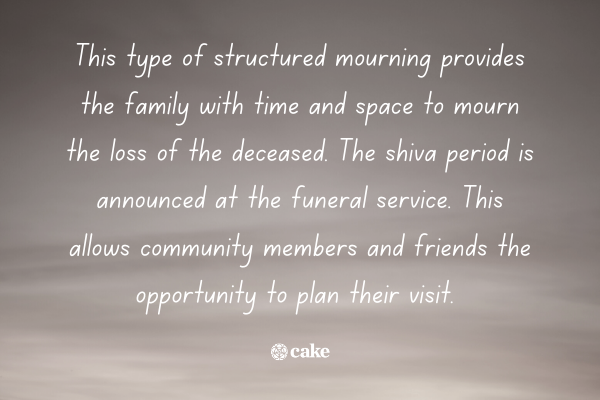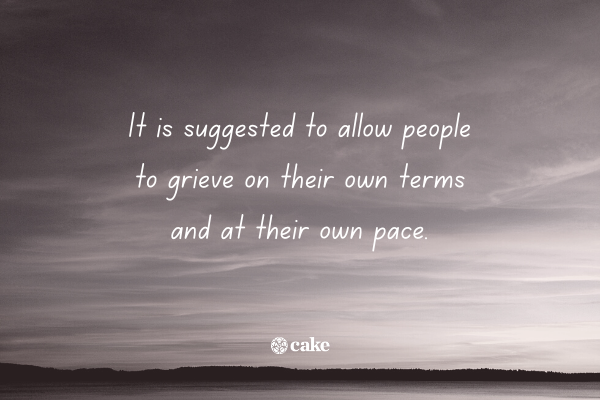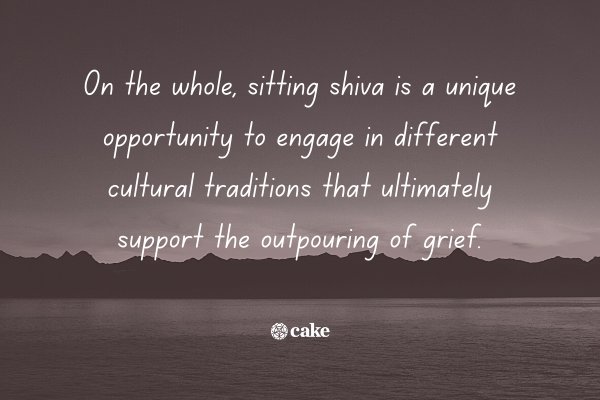Does Shiva Start Again Saturday Nighr
Jewish traditions encompass death as a part of life. Judaism also teaches that information technology'southward natural to grieve the loss of a loved one. There are five stages of mourning that begin at the fourth dimension of death in traditional Judaism: aninut, shiva, sheloshim, yud-bet chodesh, and yahrzeit.
Jump ahead to these sections:
- What's Sitting Shiva?
- Sitting Shiva Protocols and Customs
- Rules for Sitting Shiva
- Important Things to Remember at Shiva
You may be nearly familiar with — or you might have at to the lowest degree heard of — shiva. This is the mourning period that begins on the solar day of the burial and is also known as "sitting shiva." Here's what you need to know if you're not Jewish.
What's Sitting Shiva?

Traditionally, shiva lasts for approximately seven days and begins on the solar day of a Jewish funeral or burial. In this mean solar day and historic period, however, shiva lasts at to the lowest degree three days.
This blazon of structured mourning provides the family unit with time and infinite to mourn the loss of the deceased. The shiva period is announced at the funeral service. This allows community members and friends the opportunity to program their visit.
During shiva, close family unit and friends gather to grieve. This ritual dates dorsum to biblical times and the word shiva comes from the Hebrew give-and-take shiv'ah. The do of sitting shiva is a defended time to mourn and feel grief.
The Torah mentioned the offset Shiva was held when Methuselah, the oldest human being in the world, died and that he was mourned for seven days.
Sitting Shiva Protocol and Community
Shiva takes place in the home of the spouse, parent, sibling, or child of the deceased. The mourning family opens their home and invites family, friends, and community to run across them in their grief. Though shiva is a religious event, any non-Jews are welcome to this event.
It'due south customary to make a shiva call earlier visiting a family during shiva. This call is to remind mourners that they're non lonely. Yous are encouraged to mind and be compassionate back up during the call. Mourners are welcome to express sadness and heartache.
When you approach a home that'southward sitting shiva, you're invited to walk right in. As shiva is observed, the mourner's home is open to the community and everyone is welcome.
Shiva is a time to meet the mourners, to share memories and stories nigh the deceased. It'southward a time to honor a mourner's grief process without trying to right or fix it, every bit the focus is on giving space to mourn without constraint.
Your task as the visitor is to let mourners know you are there as unconditional back up and presence. Many cultural societies do not offer opportunities to grieve as a customs, often leading mourners to grieve alone and try to hide their grief from everyone. Jewish culture is unique considering information technology embraces community grief. This includes the tears, anger, sadness, and daze that may ascend during the period of immediate loss of a loved one.
Mourners are encouraged to continue conversations about the deceased, and shiva creates a safe infinite for people to grieve without being rushed along in the process. It is recommended to spend no longer than an hour when visiting to sit shiva with friends or family, so the deceased's family doesn't become too overwhelmed or tired.
Designated prayer times are ofttimes arranged in the shiva home or synagogue. A rabbi volition assist in the coordination of prayer wherever it takes place, and a rabbi is also available for guidance and i-on-one conversation during shiva.
Post-planning tip:If you are the executor for a deceased loved one, the emotional and technical aspects of treatment their unfinished business concern can be overwhelming without a way to organize your process. We have a post-loss checklist that will aid you ensure that your loved one'southward family, estate, and other affairs are taken care of.
Rules for Sitting Shiva
There are sure rituals and practices to follow that vary, depending on each dwelling house.
The lighting of the memorial candle. This candle is lit as presently as the mourners return domicile from a burial. Some families may recite a prayer in Hebrew and others might remain silent. The candle is called a ner daluk in Hebrew and it'due south lit for the entire shiva.
Mourners sit depression to the footing to signify grounding into their grief. Sitting depression also parallels any low feelings and depression they might feel.
Mirrors and reflective TVs and devices are covered . This encourages inner reflection and stillness and reminds guests that it's a time of mourning.
Kaddish is recited. Kaddish, pronounced: KAH-dish, is a Jewish funeral prayer recited during this time, where you mourn the expressionless. It's often referred to as the mourner's kaddish. A presence of 10 developed males is required to recite this prayer — the 10 adults bespeak that it's a minyan.
This prayer can have place up to iii times a day, depending on the male visitors present at the time. Taking part in this prayer is a high honor.
Shoes and socks are not worn . Sockless, shoeless anxiety signifies humility. You may also pass a bowl of h2o on your style into the house in order to wash your hands before entering. The cleansing ritual signifies a transition from honoring the dead to accompanying the mourning.
Men practise not shave and women exercise non vesture makeup. Mourners do not indulge in superficial beauties or whatever luxury grooming rituals. They are able to focus on the life and death of the deceased by taking the focus off their daily routines.
The immediate family might wear torn clothing (correct above their eye) to signify their loss. This is a time to stay apprehensive and show on their outside appearance that they are in mourning. The attire worn at a shiva should be simple and minor.
Food is served throughout shiva. Friends and neighbors bring nutrient as a sign of comfort. Mourners usually don't have much time to eat during shiva, but the food is a symbol of nourishment for the soul. Friends will often bring round foods, like bagels and donuts, to signify the circle of life. You may also encounter traditional Jewish foods like babka, challah, and rugelach.
Wine and hard liquor are usually available, along with soda and juices.
You might consider bringing a handbasket of food or snacks. Read our guide on shiva baskets for some ideas.
A guest book is placed for visitors to sign. The Jewish culture has also adapted this tradition and a condolence book is ready out. This book is an invitation for people to write a notation of hope and support to mourners.
Immediate family does not work or appoint in entertainment. This cogitating catamenia is for processing the loss and holding space for the soul that has passed. Mourners' worlds have stopped — instead of breezing past death and grief, they cease to mindfully mourn it.
Share your terminal wishes, only in case.
Create a gratis Cake end-of-life planning profile and instantly share your wellness, legal, funeral, and legacy decisions with a loved i.
Of import Things to Remember at Shiva

It is important non to bring up conversations virtually how the person died. If the immediate family wants to hash out this topic, they volition bring it upward to you. Shiva is a time to remember the deceased and provide family members a shoulder to cry on.
Information technology is suggested to allow people to grieve on their own terms and at their own pace. Each shiva can experience different, whether it'due south a family member's first shiva or their fifth — each shiva tin feel similar information technology'south the first. Be open and warmhearted and practise your listening skills. Encouraging deep listening is a compassionate souvenir you tin can provide to nurture the quiet reflection of the shiva.
Be intentional when you make your shiva call. It is of import to recognize that the person you are calling might be really buried in his or her grief. Meet him or her where he or she is and allow him or her to lead the conversation.
If you are a couple, it is important that you lot both make a shiva phone call. Each shiva call is intended to exist a one-on-one call between a mourner and a family member or friend. Try to avoid making group shiva calls out of respect for the family and the deceased.
Attending a funeral or making a shiva telephone call does non replace attending a shiva in person. If you live in the same country, it is customary to attend the funeral, brand a shiva call, and attend the shiva. This shows the family and your community that yous are present in times of suffering.
What Happens Subsequently Shiva?

When visitors go out the Shiva firm, they recite a Hebrew prayer: "Hamakom yenakhem etekhem betokh shaar avelay tziyon viyrushalayim," which means, "May God comfort you amid the other mourners of Zion and Jerusalem."
Shiva ends on the morning of either the tertiary or seventh day. At the determination of Shiva, the mourners accept a walk to symbolize moving forward. The next stage of grief in Jewish tradition is sheloshim. This word means thirty in Hebrew and this period lasts for 30 days. Unlike shiva, sheloshim is much more informal. Mourners tin can render to work and resume all other activities.
Transitioning from shiva to sheloshim can be challenging — information technology can seem abrupt to re-engage with the hustle and hurry of life after intense grief and loss. Some mourners in transition might consult a rabbi for support.
Unlike many other traditions, Jewish culture discourages frequent visits to the gravesite. Instead, there are designated times when visiting a grave is acceptable. This includes early mornings and afternoons and on certain Jewish holidays.
On the whole, sitting shiva is a unique opportunity to engage in different cultural traditions that ultimately support the outpouring of grief. In detail, showing care to the families of the deceased during their mourning periods by coming to listen to their emotions and grief over the loss of a loved one is an encouraging focus on feelings that spring upwardly subsequently this item type of trauma. Participating during a shiva period may offer new ways to reflect on sadness, and give a new softness to the experience of loss and grief.

Sources
- Abramowitz, Jack. Customs Observed in the Community Business firm, OU Torah. https://outorah.org/p/36028
- Reyim, Adat Congregation, A Guide To Jewish Mourning Laws and Practices , Shulcoud, http://images.shulcloud.com/618/uploads/PDFs/mourning5.pdf
whitehousenoung1987.blogspot.com
Source: https://www.joincake.com/blog/sitting-shiva/
Postar um comentário for "Does Shiva Start Again Saturday Nighr"